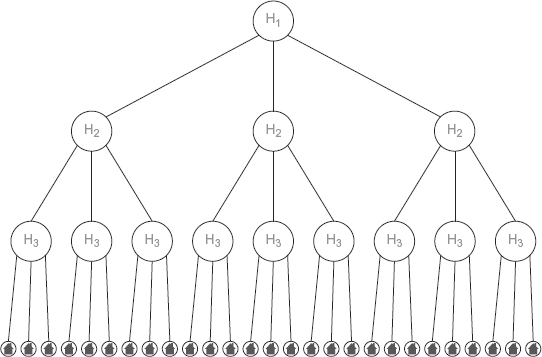Hierarchies
The organization of a hierarchy can vary. At one extreme, it has many levels, with less span of control; at the other extreme, it is flattened, with larger span of control. In the limit, this is a central hub with only one layer of “reports.” All layers may have similar fan-out, but research into actual networks, such as the Internet or real-world friendships, illustrates a range of structures, ranging from “small-world” networks, which have a mix of local and long-distance connections, and “aristrocratic” networks, which illustrate “power law” distributions: a few nodes with many connections, and many nodes with few connections.5
Hierarchical networks can be very efficient. Consider a hierarchical k-ary—for example, binary or ternary—tree (see Exhibit 24.3).
EXHIBIT 24.3 Hierarchical Tree

The structure in Exhibit 24.3 is that used by one of the oldest cloud services in existence—the plain-old telephony system (POTS)—which had five such layers. The fan-out—the number of connections to a lower level in the hierarchy—in Exhibit 24.3 is 3 but can be any integer greater than zero. In general, however, if the fan-out at any node is k and the number of levels is m, there are some straightforward calculations to determine the benefits—and trade-offs—of a cloud service.
In such a network, it is easy to see that if n is the number of endpoints, n = km. To do so requires not ...
Get Cloudonomics: The Business Value of Cloud Computing, + Website now with the O’Reilly learning platform.
O’Reilly members experience books, live events, courses curated by job role, and more from O’Reilly and nearly 200 top publishers.

